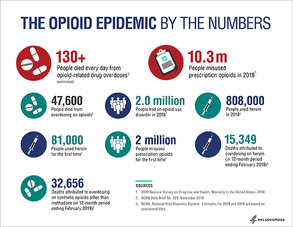 In the 1990s, the medical community was reassured by pharmaceutical companies that patients will not become addicted to opioid pain relievers. As a result, the rate at which opioids were prescribed escalated. A concern that was initially disregarded turned into a nationwide crisis, affecting nearly 2.1 million Americans yearly and resulting in about 130 deaths daily (Assistant Secretary of Public Affairs). Opioids interact with the brain and nervous system to create the sensation of relief and pleasure. Addiction causes one to feel an overwhelming craving for drugs to seek some kind of relief (even though they are harmful to you). As the misuse of opioids increased, so did deaths caused by overdose, making opioids the number one cause of accidental death in the U.S. (Opioid Addiction). The increasing occurrence of newborn babies suffering from withdrawal symptoms as a result of the misuse of opioids during pregnancy is another example of a harmful consequence. The U.S. Department of Health and Human Services (HHS) is prioritizing efforts to make treatment and recovery services more accessible as well as promoting the use of overdose-reversing medication. Taking the necessary measures to treat those suffering from opioid use disorder is a crucial part of the solution to this problem. While the HHS is attempting to aid the recovery, the National Institute of Health (NIH) is aiming to discover non-addictive alternatives for pain relief. Greater attempts of preventing opioid misuse will be the solution to this epidemic. The most efficient solution is finding alternative pain relief methods and making prescription opioids less accessible. Reducing the chance for the initial misuse of prescription opioids to occur will increase the overall safety of the population. References: Assistant Secretary of Public Affairs (ASPA). “What Is the U.S. Opioid Epidemic?” HHS.gov, Https://Plus.google.com/+HHS, www.hhs.gov/opioids/about-the-epidemic/index.html. “Drug Overdose Deaths.” Centers for Disease Control and Prevention, Centers for Disease Control and Prevention, 19 Mar. 2020, www.cdc.gov/drugoverdose/data/statedeaths.html. “How Healthcare Providers Are Fighting the Opioid Epidemic on the Front.” Premier, 20 Aug. 2020, www.premierinc.com/newsroom/blog/how-healthcare-providers-are-fighting-the-opioid-epidemic-on-the-front-lines. National Institute on Drug Abuse. “Opioid Overdose Crisis.” National Institute on Drug Abuse, 10 June 2020, www.drugabuse.gov/drug-topics/opioids/opioid-overdose-crisis. “Opioid Addiction 2016 Facts & Figures .” ASAM.org, 2016, www.asam.org/docs/default-source/advocacy/opioid-addiction-disease-facts-figures.pdf. “Opioid Misuse and Addiction Treatment.” MedlinePlus, U.S. National Library of Medicine, 4 June 2020, https://medlineplus.gov/opioidmisuseandaddictiontreatment.html. “Understanding the Epidemic.” Centers for Disease Control and Prevention, Centers for Disease Control and Prevention, 19 Mar. 2020, www.cdc.gov/drugoverdose/epidemic/index.html. Comments are closed.
|
|

